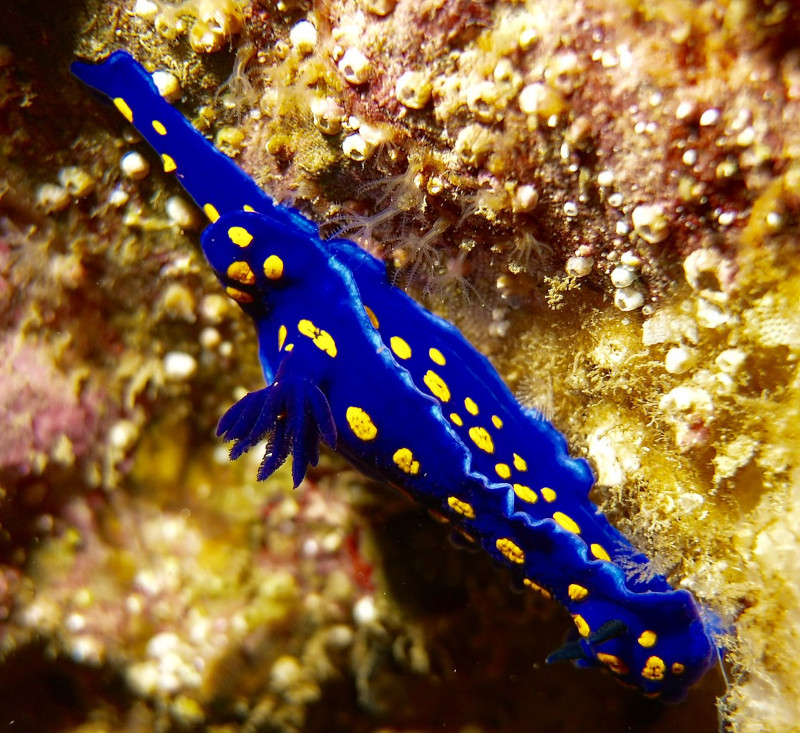California Blue Dorid Facts
- Perhaps most notably, the informative term of California Blue Dorid serves as the common name for a particularly lovely form of marine slug. However, it also bears the difficult to pronounce scientific name of the Felimare californiensis.
- While the names we use to speak of it may change, though, one fact remains apparent. That’s the fact this creature remains exceedingly rare. Unfortunately, though, researchers possess relatively little reliable data about the amazing species.
- This lamentable situation occurs mainly due to its sheer scarcity. That’s true since this quite obviously limits opportunities for observation and study. By 1984, the species had disappeared completely from the northern part of its natural range.
- However, since the year 2003, a few individual specimens of the species have been spotted in that area once again. As a result of this, scientific studies now remain ongoing, in attempts to learn more about this rare species.
- For the moment, the IUCN has no listing for the California Blue Dorid. Any such listing would appear on the organization’s Red List of Threatened Species. This regrettably occurs due to simple insufficient data, not because of hopeful scenarios.
- Many people nonetheless presently believe the remarkable species to be at risk. This belief occurs due to several factors. More specifically, these potential threats primarily consist of habitat loss, and the ongoing effects of climate change.
Related Articles
California Blue Dorid Physical Description
First of all, it must be pointed out that, although the gorgeous California Blue Dorid stands out, it does not do so due to sheer physical size. That holds true, in point of fact, due to the fact that the gastropod ranks as only a roughly average-sized member of its genus.
More precisely, adult specimens of this species, at least of the limited number studied, attain an average length of about 3.5 in (9 cm). Unlike many sea creatures, the California Blue Dorid displays no noticeable degree of the principle of sexual dimorphism.
Individuals of both genders generally show patterns of extremely bright, vivid color. As its name suggests, though the exact pattern varies among individuals, a deep blue remains paramount. Other colors nonetheless include vibrant shades of orange, and light blue.
- Kingdom: Animalia
- Phylum: Mollusca
- Class: Gastropoda
- Order: Nudibranchia
- Family: Chromodorididae
- Genus: Felimare
- Species: F. californiensis
California Blue Dorid Distribution, Habitat, and Ecology
Quite regrettably, the stunning California Blue Dorid appears to have evolved as native to an extremely restricted portion of the world. That’s because this limited zone of habitation only seems to include a very confining range extending from Monterey Bay to Baja, California.
More precisely, though, this region follows the Eastern Pacific Coast of the United States, in North America. Further complicating its situation, the species also developed to require very specific environmental conditions for it to thrive.
That’s because the invertebrate only lives in the shallow ocean waters, close to the shore. Quite naturally, this severely restricts its possibilities for expansion. This region itself, by it very nature, further remains especially vulnerable to environmental changes.
Not surprisingly, like its related species, the California Blue Dorid, evolved as a strict carnivore. In its case, however, its diet consists of various dysideid sponges. For the moment, due to limited data, this appears to be its sole source of nourishment.
Meanwhile, its own naturally evolved predators, if any, remain completely undetermined. Given its moderate toxicity, however, researchers expect its predators to be relatively few. Scientific research into this subject nonetheless presently remains ongoing.
Species Sharing Its Range
Check out our other articles on Earth’s Many Magnificent Marsupials, Clouded Leopard, Guinan cock-of-the-rock, Salar de Uyuni, Lady’s Slipper Orchid, Red Rock Crab, American Alligator

